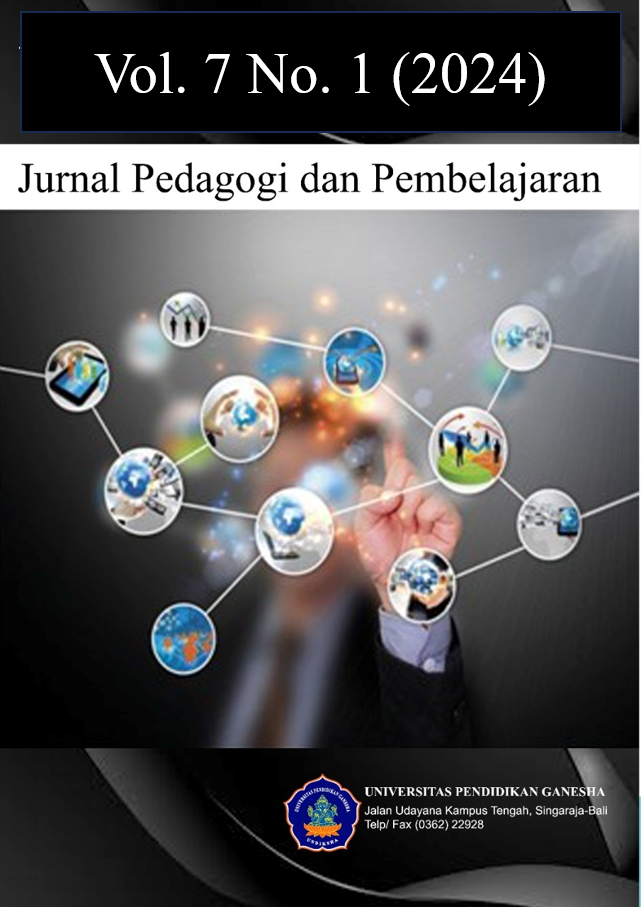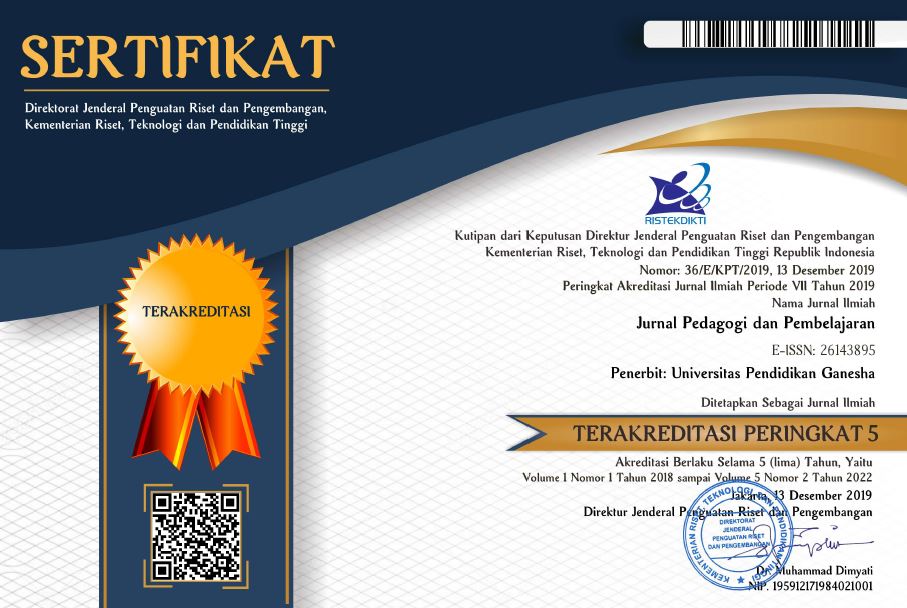Transforming English Language Learning in Elementary Schools Through Augmented Reality
DOI:
https://doi.org/10.23887/jp2.v7i1.66711Kata Kunci:
Augmented Reality, English, Elementary School, Learning Outcomes, Technology IntegrationAbstrak
The problem with learning English in elementary schools is the low learning outcomes of students, especially in understanding the material. The urgency of applying Augmented Reality (AR) technology as a learning medium is to improve students' understanding of English more interestingly and interactively. This research aims to evaluate the effectiveness of using AR in improving student learning outcomes in English subjects in elementary schools. The research method used is quantitative with the research subjects being elementary school students. The data collection technique is carried out through questionnaires filled out by students after using AR-based learning media. The data analysis technique used is a statistical analysis to measure the increase in student learning outcomes before and after using AR. The research results show that there is a significant increase in students' understanding of English material after using AR as a learning medium. This research concludes that the application of AR is effective in improving student learning outcomes in English subjects in elementary schools. The implication of this research is the need to integrate AR technology into the English language learning curriculum in elementary schools to improve the quality of learning and students' understanding of the subject matter.
Referensi
Alalwan, N., Cheng, L., Al-Samarraie, H., Yousef, R., Ibrahim Alzahrani, A., & Sarsam, S. M. (2020). Challenges and Prospects of Virtual Reality and Augmented Reality Utilization among Primary School Teachers: A Developing Country Perspective. Studies in Educational Evaluation, 66(September 2019), 100876.1-12. https://doi.org/10.1016/j.stueduc.2020.100876. DOI: https://doi.org/10.1016/j.stueduc.2020.100876
Alduais, A., Al-Qaderi, I., & Alfadda, H. (2022). Pragmatic Language Development: Analysis of Mapping Knowledge Domains on How Infants and Children Become Pragmatically Competent. Children, 9(9), 1–41. https://doi.org/10.3390/children9091407. DOI: https://doi.org/10.3390/children9091407
Andriani. (2015). Sistem Pembelajaran Berbasis Teknologi Informasi Dan Komunikasi. Jurnal Sosial Budaya: Media Komunikasi Ilmu-Ilmu Sosial Budaya, 12(1).
Aquilani, B., Piccarozzi, M., Abbate, T., & Codini, A. (2020). The role of open innovation and value co-creation in the challenging transition from industry 4.0 to society 5.0: Toward a theoretical framework. Sustainability (Switzerland), 12(21), 1–21. https://doi.org/10.3390/su12218943. DOI: https://doi.org/10.3390/su12218943
Baas, J., Schotten, M., Plume, A., Côté, G., & Karimi, R. (2020). Scopus as a curated, high-quality bibliometric data source for academic research in quantitative science studies. Quantitative Science Studies, 1(1), 377–386. https://doi.org/10.1162/qss_a_00019. DOI: https://doi.org/10.1162/qss_a_00019
Badem-Korkmaz, F., & Balaman, U. (2020). Third position repair for resolving troubles in understanding teacher instructions. Linguistics and Education, 60(December 2020), 100859.1-13. https://doi.org/10.1016/j.linged.2020.100859. DOI: https://doi.org/10.1016/j.linged.2020.100859
Bashori, M., van Hout, R., Strik, H., & Cucchiarini, C. (2021). Effects of ASR-based websites on EFL learners’ vocabulary, speaking anxiety, and language enjoyment. System, 99(July 2021), 102496.1-16. https://doi.org/10.1016/j.system.2021.102496. DOI: https://doi.org/10.1016/j.system.2021.102496
Bates, V., Hickman, C., Manchester, H., Prior, J., & Singer, S. (2020). Beyond landscape’s visible realm: Recorded sound, nature, and wellbeing. Health and Place, 61(November 2019), 102271.1-7. https://doi.org/10.1016/j.healthplace.2019.102271. DOI: https://doi.org/10.1016/j.healthplace.2019.102271
Bilfaqih, Y., & Qomarudin, M. N. (2017). Multimodal Analysis. In Dee Publish (Vol. 1). Dee Publish.
Cenoz, J., & Santos, A. (2020). Implementing pedagogical translanguaging in trilingual schools. System, 92(August 2020), 102273.1-9. https://doi.org/10.1016/j.system.2020.102273. DOI: https://doi.org/10.1016/j.system.2020.102273
Che Dalim, C. S., Sunar, M. S., Dey, A., & Billinghurst, M. (2020a). Using augmented reality with speech input for non-native children’s language learning. International Journal of Human Computer Studies, 134(2), 44–64. https://doi.org/10.1016/j.ijhcs.2019.10.002.
Che Dalim, C. S., Sunar, M. S., Dey, A., & Billinghurst, M. (2020b). Using augmented reality with speech input for non-native children’s language learning. International Journal of Human Computer Studies, 134(February 2020), 44–64. https://doi.org/10.1016/j.ijhcs.2019.10.002. DOI: https://doi.org/10.1016/j.ijhcs.2019.10.002
Chien, S. Y., Hwang, G. J., & Jong, M. S. Y. (2020). Effects of peer assessment within the context of spherical video-based virtual reality on EFL students’ English-Speaking performance and learning perceptions. Computers and Education, 146(March 2020), 103751.1-48. https://doi.org/10.1016/j.compedu.2019.103751. DOI: https://doi.org/10.1016/j.compedu.2019.103751
Danaei, D., Jamali, H. R., Mansourian, Y., & Rastegarpour, H. (2020). Comparing reading comprehension between children reading augmented reality and print storybooks. Computers and Education, 153(April), 103900.1-10. https://doi.org/10.1016/j.compedu.2020.103900. DOI: https://doi.org/10.1016/j.compedu.2020.103900
Desmiyanti, D., Yuanita, Y., & Anwar, K. (2020). Make a Match Learning for English Conversation Skills of Students with Intellectual Disabilities. Script Journal: Journal of Linguistics and English Teaching, 5(1), 23–31. https://doi.org/10.24903/sj.v5i1.378. DOI: https://doi.org/10.24903/sj.v5i1.378
Dwi, S., Eko, R., Adi, K. R., & Ratnawati, N. (2021). Pengembangan Media Evaluasi Pembelajaran IPS “ MAPS ” dengan Game Web Browser Based Learning untuk siswa SMP Development of Social Studies Evaluation Media “ MAPS ” with Game Web Browser Based Learning for Junior High School Students. 25–42. https://doi.org/10.15548/jpips.v8i1.12266. DOI: https://doi.org/10.18860/jpips.v8i1.12266
Faqih, K. M. S. (2022). Factors influencing the behavioral intention to adopt a technological innovation from a developing country context: The case of mobile augmented reality games. Technology in Society, 69(March 2022), 1-15. https://doi.org/10.1016/j.techsoc.2022.101958. DOI: https://doi.org/10.1016/j.techsoc.2022.101958
Fukuda, K. (2020). Science, technology and innovation ecosystem transformation toward society 5.0. International Journal of Production Economics, 220(April), 107460.1-14. https://doi.org/10.1016/j.ijpe.2019.07.033. DOI: https://doi.org/10.1016/j.ijpe.2019.07.033
Haleem, A., Javaid, M., Qadri, M. A., & Suman, R. (2022). Understanding the role of digital technologies in education: A review. Sustainable Operations and Computers, 3(May), 275–285. https://doi.org/10.1016/j.susoc.2022.05.004. DOI: https://doi.org/10.1016/j.susoc.2022.05.004
Harrison, C. (2017). Multimodal Analysis For Education. Technical Communication, 1, 46–60.
Hu, X., & McGeown, S. (2020). Exploring the relationship between foreign language motivation and achievement among primary school students learning English in China. System, 89(April 2020), 102199.1-10. https://doi.org/10.1016/j.system.2020.102199. DOI: https://doi.org/10.1016/j.system.2020.102199
Hussein, E., Daoud, S., Alrabaiah, H., & Badawi, R. (2020). Exploring undergraduate students’ attitudes towards emergency online learning during COVID-19: A case from the UAE. Children and Youth Services Review, 119(November 2020.), 1-7. https://doi.org/10.1016/j.childyouth.2020.105699. DOI: https://doi.org/10.1016/j.childyouth.2020.105699
Ibna Seraj, P. M., & Habil, H. (2021). A systematic overview of issues for developing EFL learners’ oral English communication skills. Journal of Language and Education, 7(1), 229–240. https://doi.org/10.17323/jle.2021.10737. DOI: https://doi.org/10.17323/jle.2021.10737
Kress, G., & van Leeuwen, T. (2016). Reading Images The Grammar of Visual Desing. New York: Routledge, 2.
Mailani, E. (2019). Media Pembelajaran Matematika. Azizah Publishing.
Manuli, A., Maggio, M. G., Latella, D., Cannavò, A., Balletta, T., De Luca, R., Naro, A., & Calabrò, R. S. (2020). Can robotic gait rehabilitation plus Virtual Reality affect cognitive and behavioural outcomes in patients with chronic stroke? A randomized controlled trial involving three different protocols. Journal of Stroke and Cerebrovascular Diseases, 29(8), 1–9. https://doi.org/10.1016/j.jstrokecerebrovasdis.2020.104994. DOI: https://doi.org/10.1016/j.jstrokecerebrovasdis.2020.104994
Markowitz, A. J., & Ansari, A. (2020). Changes in academic instructional experiences in Head Start classrooms from 2001–2015. Early Childhood Research Quarterly, 53(Quarter 2020), 534–550. https://doi.org/10.1016/j.ecresq.2020.06.008. DOI: https://doi.org/10.1016/j.ecresq.2020.06.008
Meneses. (2018). The effects of multimodal texts on science reading comprehension in Chilean fifth-graders: Text scaffolding and comprehension skills. International Journal of Science Education, 40(18). DOI: https://doi.org/10.1080/09500693.2018.1527472
Mora, H., Signes-Pont, M. T., Fuster-Guilló, A., & Pertegal-Felices, M. L. (2020). A collaborative working model for enhancing the learning process of science & engineering students. Computers in Human Behavior, 103(1), 140–150. https://doi.org/10.1016/j.chb.2019.09.008. DOI: https://doi.org/10.1016/j.chb.2019.09.008
Murica. (2018). Interactive and multimodal pedagogy: A case study of how teachers and students use interactive whiteboard technology in primary science. Australian Journal of Education, 58(1), 74–88. DOI: https://doi.org/10.1177/0004944113517834
Ningsih. (2018). Pengaruh perkembangan revolusi industri 4.0 dalam dunia teknologi Pendidikan di indonesia. Junal Fakultas Komputer, 1–12. DOI: https://doi.org/10.31219/osf.io/pswmu
O’Brien, R., Beeke, S., Pilnick, A., Goldberg, S. E., & Harwood, R. H. (2020). When people living with dementia say ‘no’: Negotiating refusal in the acute hospital setting. Social Science and Medicine, 263(June), 113188.1-10. https://doi.org/10.1016/j.socscimed.2020.113188. DOI: https://doi.org/10.1016/j.socscimed.2020.113188
Parmaxi, A., & Demetriou, A. A. (2020). Augmented reality in language learning: A state-of-the-art review of 2014–2019. Journal of Computer Assisted Learning, 36(6), 861–875. https://doi.org/10.1111/jcal.12486. DOI: https://doi.org/10.1111/jcal.12486
Phoocharoensil, S. (2022). ELT and AL Research Trends in Thai SCOPUS-indexed Journals. Pasaa, 64(December), 163–193. https://eric.ed.gov/?id=EJ1376445. DOI: https://doi.org/10.58837/CHULA.PASAA.64.1.8
Prasetio, A. (2019). Pengembangan Bahan Ajar IPS menggunakan Augmented Reality di Sekolah Dasar. Management Analysis Journal, 1(4), 1–8.
Rambe, R. . (2019). Analysis Multimodal In School (Cendekia Press (ed.)).
Rovira, M. S., Turro, M. R., Fioretti, R. M. S., & Velilla, M. C. (2018). Multimodal Campus Project: Pilot Test of Voice Supported Reading. Procedia - Social and Behavioral Sciences, 190, 190–197. DOI: https://doi.org/10.1016/j.sbspro.2015.07.027
Saadon, N. F. S. M., Ahmad, I., & Pee, A. N. C. (2020). The Implementation of Augmented Reality in Increasing Student Motivation: Systematic Literature Review. IOP Conference Series: Materials Science and Engineering, 854(1), 1-8. https://doi.org/10.1088/1757-899X/854/1/012043. DOI: https://doi.org/10.1088/1757-899X/854/1/012043
Sari, S. . (2020). Analisis Multimodal. Journal Of Reflection : Ekonomic, Accounting, Management Business, 3, 291–300. DOI: https://doi.org/10.37481/sjr.v3i3.224
Seuren, L. M., Wherton, J., Greenhalgh, T., & Shaw, S. E. (2021). Whose turn is it anyway? Latency and the organization of turn-taking in video-mediated interaction. Journal of Pragmatics, 172(January 2021), 63–78. https://doi.org/10.1016/j.pragma.2020.11.005. DOI: https://doi.org/10.1016/j.pragma.2020.11.005
Sugiyono. (2015). Metode Penelitian dan pengembangan. Alfabeta.
Sugiyono. (2017). Metode Penelitian Kuantitatif, kualitatif dan R&D. Alfabeta.
Suryana & Indrawati. (2018). Pengembangan Media Pembelajaran Berbasis Permainan Tradisional “Geprek Kaleng” untuk menanamkan konsep Pecahan Siswa Kelas III SD. JPGSD Surabaya, 06(03), 219-228.
Syamsuar, & R. (2018). Pendidikan Dan Tantangan Pembelajaran Berbasis Teknologi Informasi Di Era Revolusi Industri 4.0. E-Tech : Jurnal Ilmiah Teknologi Pendidikan, 6(2). DOI: https://doi.org/10.24036/et.v2i2.101343
Talwar, S., Talwar, M., Kaur, P., & Dhir, A. (2020). Consumers’ resistance to digital innovations: A systematic review and framework development. Australasian Marketing Journal, 28(4), 286–299. https://doi.org/10.1016/j.ausmj.2020.06.014. DOI: https://doi.org/10.1016/j.ausmj.2020.06.014
Thees, M., Kapp, S., Strzys, M. P., Beil, F., & Lukowicz, P. (2020). Computers in Human Behavior Effects of augmented reality on learning and cognitive load in university physics laboratory courses. Computers in Human Behavior, 108(July 2020), 106316.1-11. https://doi.org/10.1016/j.chb.2020.106316. DOI: https://doi.org/10.1016/j.chb.2020.106316
Verawati dan Desprayoga. (2019). Learning Solutions 4.0: Hybrid Learning. Prosiding Seminar Nasional Pendidikan Program Pascasarjana Universitas Pgri Palembang, 1183–1192.
Viitaharju, P., Nieminen, M., Linnera, J., Yliniemi, K., & Karttunen, A. J. (2023). Student experiences from virtual reality-based chemistry laboratory exercises. Education for Chemical Engineers, 44(April), 191–199. https://doi.org/10.1016/j.ece.2023.06.004. DOI: https://doi.org/10.1016/j.ece.2023.06.004
Yang, Q. F., Chang, S. C., Hwang, G. J., & Zou, D. (2020). Balancing cognitive complexity and gaming level: Effects of a cognitive complexity-based competition game on EFL students’ English vocabulary learning performance, anxiety and behaviors. Computers and Education, 148(December 2019), 103808.1-21. https://doi.org/10.1016/j.compedu.2020.103808. DOI: https://doi.org/10.1016/j.compedu.2020.103808
Zhai, C., & Wibowo, S. (2023). A systematic review on artificial intelligence dialogue systems for enhancing English as foreign language students’ interactional competence in the university. Computers and Education: Artificial Intelligence, 4(March), 100134.1-26. https://doi.org/10.1016/j.caeai.2023.100134. DOI: https://doi.org/10.1016/j.caeai.2023.100134
Zhang, J., Li, G., Huang, Q., Feng, Q., & Luo, H. (2022). Augmented Reality in K–12 Education: A Systematic Review and Meta-Analysis of the Literature from 2000 to 2020. Sustainability (Switzerland), 14(15), 1-22. https://doi.org/10.3390/su14159725. DOI: https://doi.org/10.3390/su14159725
Unduhan
Diterbitkan
Cara Mengutip
Terbitan
Bagian
Lisensi
Hak Cipta (c) 2024 Yulian Purnama, Pikir Wisnu Wijayanto, Yelly Andriani Barlian , Sri Nurbani, Isry Laila Syathroh

Artikel ini berlisensiCreative Commons Attribution-ShareAlike 4.0 International License.
Authors who publish with Jurnal Pedagogi dan Pembelajaran agree to the following terms:
- Authors retain copyright and grant the journal the right of first publication with the work simultaneously licensed under a Attribution-ShareAlike 4.0 International (CC BY-SA 4.0) that allows others to share the work with an acknowledgment of the work's authorship and initial publication in this journal
- Authors are able to enter into separate, additional contractual arrangements for the non-exclusive distribution of the journal's published version of the work (e.g., post it to an institutional repository or publish it in a book), with an acknowledgment of its initial publication in this journal.
- Authors are permitted and encouraged to post their work online (e.g., in institutional repositories or on their website) prior to and during the submission process, as it can lead to productive exchanges, as well as earlier and greater citation of published work. (See The Effect of Open Access)











